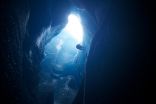(Press-News.org) A new model developed by researchers at the University of Cambridge has shown that despite its apparent stability, the massive ice sheet covering most of Greenland is more sensitive to climate change than earlier estimates have suggested, which would accelerate the rising sea levels that threaten coastal communities worldwide.
In addition to assessing the impact of the increasing levels of meltwater created and spilled into the ocean each year as the climate continues to warm, the new model also takes into account the role that the soft, spongy ground beneath the ice sheet plays in its changing dynamics. Details are published today (29 September) in the journal Nature Communications.
The Greenland Ice Sheet, which is the second-largest ice sheet in the world, covers 1.7 million square kilometres - an area roughly eight times the size of the United Kingdom - and contains enough ice to raise sea levels by more than seven metres if it were to be lost altogether.
Currently, due to surface melting alone, it is losing ice at a net annual rate of 200 gigatonnes, equating to 0.6 millimetres of sea level rise. A similarly large, but ultimately more uncertain source of sea level rise is tied to a net annual ice loss caused by increased movement of the ice sheet, which results in more ice being discharged into the ocean. Globally, sea levels are rising at three millimetres annually.
Large ice sheets such as in Greenland are far from stationary. Different parts of the ice often move at different speeds, causing ice to shear, a phenomenon known as ice flow.
"When these large ice sheets melt, whether that's due to seasonal change or a warming climate, they don't melt like an ice cube," said Dr Marion Bougamont of Cambridge's Scott Polar Research Institute, who led the research. "Instead, there are two sources of net ice loss: melting on the surface and increased flow of the ice itself, and there is a connection between these two mechanisms which we don't fully understand and isn't taken into account by standard ice sheet models."
Whereas other models of the Greenland Ice Sheet typically assume the ice slides over hard and impermeable bedrock - an assumption which is largely practical and based on lack of constraints - this study incorporates new evidence from ground-based surveys, which show soft and porous sediments at the bed of the ice sheet, more like the soft and muddy bottom of a lake than a sheet of solid rock. The new study specifically identifies the intake and temporal storage of water by weak sediment beneath the ice sheet as a crucial process in governing the ice flow.
Using a three-dimensional ice sheet model, together with an observational record of surface melting produced by collaborators at Aberystwyth University, Dr Bougamont and Dr Poul Christoffersen were able to accurately reproduce how the ice sheet's seasonal movement changes in response to the amount of surface meltwater being delivered to the ground below.
Lakes which form on the surfaces of glaciers, known as supraglacial lakes, are often created during the melt season, and typically last from early June to late August. Co-author Professor Alun Hubbard of Aberystwyth University studied these lakes and found that many empty in just a matter of hours, when hydrofracturing opens up water-filled crevasses, resulting in huge amounts of water entering and flooding the subglacial environment. In warmer years, these high-discharge drainage events are expected to become even more frequent.
"Not only is the ice sheet sensitive to a changing climate, but extreme meteorological events, such as heavy rainfall and heat waves, can also have a large effect on the rate of ice loss," said Dr Christoffersen. "The soft sediment gets weaker as it tries to soak up more water, making it less resistant, so that the ice above moves faster. The Greenland Ice Sheet is not nearly as stable as we think."
While complete loss of all ice in Greenland is judged to be extremely unlikely during this century, the record extent of surface melting in the past decade clearly shows that the ice sheet is responding to Earth's changing climate.
In this study, the researchers used two different approaches. First, they used the total amount of surface runoff as a means to drive their model, but the outcome from this experiment was inconsistent with observations. They then used only water stored temporarily in supraglacial lakes on the ice sheet's surface. They found that although only a small fraction of the total amount of meltwater produced on the surface is stored in supraglacial lakes, the high magnitude and frequency of lake drainage events causes the ice sheet to immediately accelerate as observed.
Having accurately reproduced the hydrological response of ice flow along the western margin of the ice sheet, the authors were able to subsequently evaluate the sensitivity of flow to warmer climatic conditions, resulting in more meltwater on the surface. This showed stable annual flow under present-day conditions, but a more vulnerable ice sheet in warmer years when more meltwater reaches the bed via frequent high-discharge drainage events, not only because of the emptying of supraglacial lakes such as the ones currently observed, but also because daily variations in melt volume will become equally large. The study concludes that there is a limit on how much water can be stored in the soft ground beneath the Greenland Ice Sheet. This makes it sensitive to climate change as well as to increased frequency of short-lived, but extreme, meteorological events including rainfall and heat waves.
INFORMATION:
The work was funded by the Natural Environment Research Council (NERC).
For additional information, or high-resolution images, please contact:
Sarah Collins, Office of Communications
University of Cambridge
Tel: +44 (0)1223 765542, Mob: +44 (0)7525 337458
Email: sarah.collins@admin.cam.ac.uk
Notes for editors:
1. The paper, "Sensitive response of the Greenland Ice Sheet to surface melt drainage over a soft bed" is published on 29 September in the journal Nature Communications: doi:10.1038/ncomms6052
Greenland Ice Sheet more vulnerable to climate change than previously thought
2014-09-29
ELSE PRESS RELEASES FROM THIS DATE:
Scientists discover a new role for estrogen in the pathology of breast cancer
2014-09-29
CHAMPAIGN, Ill. — Scientists have discovered a previously unknown mechanism by which estrogen prepares cells to divide, grow and, in the case of estrogen-positive breast cancers, resist cancer drugs. The researchers say the work reveals new targets for breast cancer therapy and will help doctors predict which patients need the most aggressive treatment.
The University of Illinois team reports its findings in the journal Oncogene.
Estrogen pre-activates the unfolded-protein response (UPR), a pathway that normally protects cells from stress, the researchers report. The ...
Climate change appears a mixed bag for a common frog
2014-09-29
Scientists have found amphibians worldwide are breeding earlier due to climate change, but how that affects species is just now being answered.
After warmer winters, wood frogs breed earlier and produce fewer eggs, a Case Western Reserve University researcher has found.
Michael F. Benard, the George B. Mayer Chair in Urban and Environmental Studies and assistant professor of biology, also found that frogs produce more eggs during winters with more rain and snow.
Benard's study, published today in the journal Global Change Biology, is among the first in a natural habitat ...
After-school exercise program enhances cognition in 7-, 8- and 9-year-olds
2014-09-29
CHAMPAIGN, Ill. — A nine-month-long, randomized controlled trial involving 221 prepubescent children found that those who engaged in moderate-to-vigorous physical activity for at least 60 minutes a day after school saw substantial improvements in their ability to pay attention, avoid distraction and switch between cognitive tasks, researchers report in the journal Pediatrics.
Half of the study subjects were randomly assigned to the after-school program and the rest were placed on a wait list. All participants underwent cognitive testing and brain imaging before and after ...
Hand size appears to stay constant, providing natural 'ruler'
2014-09-29
People tend to perceive their dominant hand as staying relatively the same size even when it's magnified, lending support to the idea that we use our hand as a constant perceptual "ruler" to measure the world around us. The findings are published in Psychological Science, a journal of the Association for Psychological Science.
"These findings suggest that our bodies are used as perceptual metrics, meaning that we are more likely to attribute changes in the perceived size of the hand to changes in the world — instead of thinking that our hand has become bigger, we're more ...
More children admitted to intensive care but with lower staffing ratios
2014-09-29
More children than ever are being admitted to intensive care units in England and Wales but there are fewer staff per bed available to cope with the increase, according to a new report published jointly by the University of Leeds and University of Leicester.
The Paediatric Intensive Care Audit Network (PICANet) report showed that there was a 15% increase in admissions over a 10-year period between 2004 and 2013, but this included an increase of 4% that was not due to changes in the childhood population.
At the same time, staffing levels have increased by 36% but this ...
Researchers identify early sign of pancreatic cancer
2014-09-28
BOSTON –– Scientists at Dana-Farber Cancer Institute, the Massachusetts Institute of Technology, and other institutions have discovered a sign of the early development of pancreatic cancer – an upsurge in certain amino acids that occurs before the disease is diagnosed and symptoms appear. The research is being published online today by the journal Nature Medicine.
Although the increase isn't large enough to be the basis of a new test for early detection of the disease, the findings will help researchers better understand how pancreatic cancer affects the rest of the body, ...
Human genome was shaped by an evolutionary arms race with itself
2014-09-28
New findings by scientists at the University of California, Santa Cruz, suggest that an evolutionary arms race between rival elements within the genomes of primates drove the evolution of complex regulatory networks that orchestrate the activity of genes in every cell of our bodies.
The arms race is between mobile DNA sequences known as "retrotransposons" (a.k.a. "jumping genes") and the genes that have evolved to control them. The UC Santa Cruz researchers have, for the first time, identified genes in humans that make repressor proteins to shut down specific jumping ...
Docetaxel or pemetrexed with cisplatin achieve comparable outcomes in non-squamous Lu Ca
2014-09-27
The first direct comparison of treating non-squamous lung cancer with either pemetrexed or docetaxel in addition to cisplatin has shown that the two combinations achieve similar progression-free survival, although docetaxel was associated with more frequent adverse events.
At the ESMO 2014 Congress in Madrid, Dr Young-Chul Kim from Chonnam National University Medical School, South Korea, reported the results of an open-label phase III trial that included 149 patients with non-squamous non-small cell lung cancer (NSCLC) conducted at 14 centres in South Korea.
"We wanted ...
Customising chemotherapy in Lu Ca: New Ph II data reported in 2 LB studies
2014-09-27
Measuring the expression levels of an enzyme involved in DNA synthesis can help predict the response of lung cancers to certain treatments, a Korean study has shown at the ESMO 2014 Congress in Madrid.
In a randomized phase II study, researchers showed that patients whose lung cancers expressed low levels of an enzyme called thymidylate synthase experienced a greater benefit from treatment with the combination of pemetrexed and cisplatin than those whose tumours expressed high levels.
"Thymidylate synthase is one of the proteins that is targeted by pemetrexed which ...
French studies measure benefits of colorectal cancer screening
2014-09-27
The introduction of biennial colorectal cancer screening in a region of France increased the rate of diagnosis of high risk pre-cancerous adenomas (sometimes called polyps) by 89%, researchers have reported at the ESMO 2014 Congress in Madrid.
Dr Vanessa Cottet from INSERM Unité 866 in Dijon, France, and colleagues studied the region of Côte-d'Or, where a registry has been collecting data on adenomas since 1976. They wanted to evaluate the rate of diagnosis of adenomas before and after the initiation of a screening program using fecal occult blood testing that began ...





